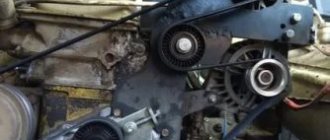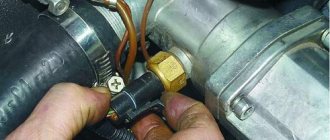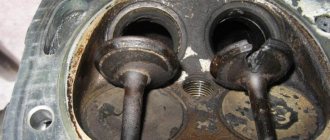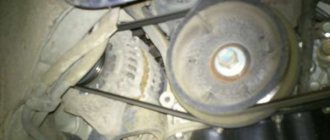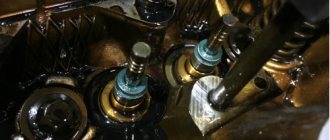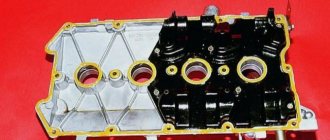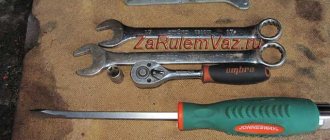Why is it necessary to set the labels correctly?
For the correct operation of the gas distribution mechanism of a car, it is necessary that the closing and opening of the valves occur in a strictly defined sequence. The slightest inaccuracy in the operation of the camshaft and crankshaft leads to the fact that the gas exchange process in the cylinders is disrupted, and the engine stops working in the correct mode.
A timing belt is a rubber part that during operation can wear out, crack, tear, etc. Therefore, it is necessary to replace the element in a timely manner.
When installing a new one, you should set the labels correctly. This is necessary to ensure that the engine operates correctly from the first seconds of startup. If installed incorrectly, serious problems can occur, including engine failure.
The main reasons why the timing belt jumps
This is how a timing belt works.
The timing belt is an important element of the car, so it needs to be serviced promptly. The reasons that lead to its jump are the following:
- Contact of oil or cooling liquid on the belt surface
- Improper use
- Late replacement
- External damage
- Incorrectly placed labels
- Difficult operating conditions
- Low quality spare parts
Of course, these are not all cases due to which the timing belt breaks or jumps. But this can be understood by the following signs.
Tools needed for work
Installing marks is not an easy process and if done incorrectly, you risk spending a lot of time installing the part. And that's not the worst thing. There are cases when careless drivers break the engine and other mechanisms of the car.
First of all, stock up on the necessary tools:
- Socket head.
- Jack to raise the car.
- Keys No. 17 or 19 - depends on what kind of car you have.
Advice: it is better that you have all key diameters starting from No. 10.
Large flat head screwdriver.
Labeling
Before starting work, you need to understand that it is important that during the process of replacing the timing belt, the pre-set risks do not go astray. Otherwise, you will have to go deeper into the settings and spend more than one hour installing the part.
When installing the timing belt, it is important to align the pistons so that in the first cylinder the piston is at the highest point of the first cylinder. In this position, the piston is at its maximum distance from the crankshaft. This is the position the engine is in when the marks are correctly set. In this position it is necessary to change the timing belt.
The number of marks, as well as their location, may vary depending on your engine type.
The following marks can be distinguished:
- Mark on the flywheel.
- Mark on the pulley.
- Camshaft mark (two on a 16 valve engine).
If the timing belt has jumped or broken | Motorist's benefit
The timing belt on a car engine ensures synchronization of the crankshaft with the timing shaft (camshaft). On engines with a timing belt, breaking it or slipping even one tooth can lead to serious problems, which in the future may lead to a major overhaul of the engine.
Signs of a timing belt that has jumped on the pulley
If the timing belt has jumped, the symptoms may be as follows:
- Unstable motor operation
There may be several reasons why the timing belt may jump. Firstly, low tension, and secondly, the presence of oil on the camshaft or crankshaft pulley can cause the belt to slip. Well, and most importantly, a broken timing belt can ultimately lead to damage to the valves of the gas distribution mechanism and internal elements of the internal combustion engine (pistons, connecting rods, etc.)
Broken timing belt while driving
Causes of timing belt breakage
Why does the timing belt break? There may be several reasons for this, and one of the main ones is its wear and tear. Therefore, the manufacturer strongly recommends replacing the timing belt within the vehicle mileage interval specified by the regulations. Next, it is worth noting that the tension roller is damaged or weakened, which can undoubtedly cause the belt to break or slip. The cause of the break may also be a jammed water pump pulley. If the engine has two camshafts, then the failure of one can also be a consequence of a broken timing belt, but in this case the consequences can be completely different, more disappointing.
Consequences of a broken timing belt on a Lada Priora engine
How to avoid timing belt breakage or slippage
First of all, it is necessary to strictly observe the timing belt replacement interval, in most cases this is 60,000 km. vehicle mileage. Next, keep an eye on the oil seals, including the crankshaft; oil drips under the hood are a sign of one of them leaking. Periodically check the tension of the timing belt; if it becomes loose, immediately take measures to tighten it. Always use original spare parts when replacing a belt. This also includes replacing the pump; buy only the one recommended by the manufacturer.
Find out in more detail when it is necessary to change the timing belt on an internal combustion engine
Photo reports on replacing the timing belt
Opel Astra Renault Logan Audi A4 Audi 100 Chevrolet Lacetti Chevrolet Aveo On diesel engines Volkswagen Toyota Estima Emina 3C Renault 25 Mazda Demio
The timing belt has an important function in the operation of the vehicle's power plant. But like any part, it can periodically malfunction. The situation when the timing belt has jumped is familiar to many car enthusiasts. It may jump one or more teeth on the pulley. This may cause vehicle damage.
Replacing a timing belt without marks
In some cases, it is necessary to install the belt if there are no marks.
For this you will need:
First of all, remove the belt protective cover and unscrew the spark plugs.
Let's take a closer look at the process of replacing a belt without marks on an 8-valve engine.
- It is necessary to align the camshaft in the overlap, for example, it is convenient to select the second cylinder. To do this you will need a caliper and a screwdriver. Slowly turn the camshaft clockwise and observe the overlap position. To do this, use a barbell. Place it on the expansion joints and rotate the camshaft until the expansion joints are at the same height. That is, the position of the barbell should be straight, not beveled.
- After determining the overlap, it is necessary to set the TDC (top dead center) of the second cylinder. Insert a screwdriver into the spark plug channel. Slowly rotate the engine, only in the direction of engine movement, so that the piston rises up. At a certain point, you will feel that the flywheel begins to rotate easily. After this, you need to feel the lower and upper points with your hand and set the upper one.
- After adjustments, put on the new belt so that it matches, you may need to turn it a little. And also pull it tight.
- The next stage is checking the belt installation. Rotate the flywheel and look for a mark on it. Set it to the top position and check the marks on the camshaft. If the adjustment is made inaccurately, the risks will disappear.
On a 16-valve engine (2 camshafts), the installation is carried out according to the same principle.
How to correctly set marks during the process of replacing/installing a belt on a “nine”
The timing belt on cars with front-wheel drive is carried out using a toothed belt. Each successive replacement of the AvtoVAZ belt is recommended after 65,000 miles. In addition to replacing the element itself, it is also recommended to change the roller.
The algorithm for replacing the timing belt is as follows:
- First of all, a new belt and roller are purchased (it is advisable that both elements are recommended by the car manufacturer);
- The car is placed on a level surface;
- The battery is de-energized (due to the exception of a short circuit during the work process);
- The car is secured with special anti-rollback stops;
- The protective cover is removed from the timing system;
- The power unit is set according to the marks.
It is important to be able to set the marks so that in the front part of the engine the mark on the camshaft wheel coincides with the upper boss on the belt cover.
As for the second mark, it is connected to the clutch cover hatch. It is located under the distributor. This hatch is protected by a special rubber plug, which must be pulled out. And if the marks are set correctly, you should check the mark on the hatch: if in the triangle of the hatch you can see a mark that coincides with the end of the flywheel, then everything is correct.
The belt replacement procedure continues:
- The right wheel of the VAZ is dismantled (before this, a reliable support must be placed under the car body, for example, an empty 20-liter container for fuel on the edge);
- The protective type belly is disassembled to gain access to the shaft wheel and belt, respectively;
- The tension of the generator belt is weakened by moving it in the direction of the BC;
- The belt is dismantled;
- The bolt securing the pulley is unscrewed using special tools (mount, head, etc.).
Advice. During the work, in order to securely fix the flywheel from spinning, it is recommended to insert a strong metal rod (screwdriver, pry bar) between its teeth.
- After this, you can completely unscrew the wheel bolt and then remove the crankshaft pulley.
Note. The crankshaft pulley (wheel) cannot be completely removed. He is left hanging.
- The tension roller clamps are loosened.
- The timing belt is removed along with the roller.
- A new roller is installed in place, and a new timing belt is installed.
Consequences of incorrect labeling
If the timing marks are set incorrectly, serious consequences for the car can occur.
The most common cases:
- Due to misaligned timing, valves can become deformed during engine operation, and the damage will accumulate.
- The valves will become deformed - bent. Although this will not happen in an 8-valve engine.
- Due to deformation of the valves, the cylinder head may be damaged. As a result, the guide bushings will fail, and cracks may appear on the main power elements.
- The piston mechanism may burn out due to incorrect placement of the timing marks.
- There will be an oil residue on the spark plugs. Plus, the ignition moment of the fuel mixture worsens.
- And also other unpleasant consequences arise.
The timing belt jumped onto a tooth of a VAZ car: signs, symptoms and repair methods
Like any other car component or part, the timing belt performs certain functions. It is entrusted with a significant option, and due to the convincingness of its functioning, the operational duration and security of the automotive power plant as a whole is determined.
Can the timing belt jump?
Author's note: Jumping or slipping of the timing belt is a fairly common phenomenon familiar to many motorists. The belt slips one tooth or several. We are talking about the teeth of the crankshaft or camshaft flywheel. It is clear that such a situation can lead to serious problems.
The main reasons why the timing belt jumps
This is how a timing belt works
The timing belt is an important element of the car, so it needs to be serviced promptly. The reasons that lead to its jump are the following:
- Contact of oil or cooling liquid on the belt surface
- Improper use
- Late replacement
- External damage
- Incorrectly placed labels
- Difficult operating conditions
- Low quality spare parts
Of course, these are not all cases due to which the timing belt breaks or jumps. But this can be understood by the following signs.
What to do if the timing belt on a Priora has jumped - video
Signs and Symptoms of a Timing Belt Jumping
In internal combustion engines that use a timing belt in the timing drive, there is always the danger of it jumping over one or more teeth.
If the timing belt has jumped, the signs of this, depending on the design of the engine, may be the following:
- Unstable engine operation
- The engine stalls
- Power Loss
- Poor startup or inability to start at all
- Engine wedge
Author's Notes: As a rule, if the timing belt jumps within two teeth, the engine will continue to run, but with visible interruptions. When the belt jumps more than two teeth, the consequences can be very different.
Using front-wheel drive vases as an example, the following happens:
- 1.1 and 1.3 liter engines there will be a meeting of valves with pistons with all the ensuing consequences;
- 1.5 and 1.6 liter engines the valves remain intact, but the engine begins to behave inappropriately.
- on some models of modern engines, the valves remain intact, but the rocker breaks, which makes subsequent repairs cheaper.
A similar malfunction, such as a timing belt that has jumped, is usually caused by either an oil leak that has reached the belt teeth, an antifreeze leak, a faulty tension roller, or extreme belt wear.
What to do if your timing belt has jumped one or more teeth
As a rule, a timing belt jump does not immediately lead to extreme problems, but the engine begins to function intermittently or does not start. The explanation is simple: the gas protection phases are incorrect, the general cycle of fuel supply and cylinder cleaning is disrupted.
Timing belt assembly with rollers
The reason for timing belt jumping is often due to the fact that a little oil or coolant drips onto the rubber material of the timing element. The pump is leaking, the cuff of any shaft is malfunctioning - in a word, anything related to oil or liquids can lead to this. Therefore, if you find a malfunction, you must do the following:
- When inspecting the engine, oil leaks will be visible on the timing belt cover, so when opening the hood to check the oil level, you should always pay attention to the cleanliness of this cover.
- If the belt cover has no visible traces of oil, and the engine operation has changed dramatically, you need to remove the cover and check the alignment of the marks and the tension of the timing belt.
- When traces of oil are found, it is necessary to remove the cover and carefully inspect the belt and find the location of the oil leak. This could be crankshaft or camshaft seals, a leaking pump, or, for example, a leaking oil pressure sensor on VAZ 2108-09 engines and their families. The sensor is located just above the belt cover (top left) and when it is squeezed out, the oil flows just under the belt cover.
- In such a situation, it is necessary to replace the failed parts and if the timing belt is in oil, then replace the belt as well.
- After removing the timing belt, it is necessary to clean all parts from traces of oil.
- When replacing a belt, try to set the marks as accurately as possible, since a belt that is “knocked down” by one tooth will certainly affect the operation of the engine and its starting. This especially applies to diesel engines, which are the most demanding in terms of matching valve timing.
- If the design does not provide an automatic roller tensioner, then it is necessary to check the belt tension.
At the final stage of work, check the identity of the marks again. For example, while the crankshaft flywheel is removed, you can additionally diagnose the mark on the crankshaft by comparing the mark on the shaft sprocket and the cutout on the oil pump boss. If the marks are not in place, you will have to repeat the installation again. This is done until the marks match. After this, the crankshaft is turned two turns, and compatibility is re-diagnosed. If the marks match, you need to proceed to assembly.
How to understand that the marks are knocked down, symptoms
After replacing the belt, a situation may arise that the marks were installed incorrectly. How to determine this is described below.
- Traction and throttle response disappear.
- The car begins to accelerate more slowly.
- The engine gets very hot.
At the end of the article, we would like to note that not every car owner can correctly set the timing marks. It is necessary to have information about the operation of the engine and its design features. If you don’t want to spend a single hour setting up the mechanisms, we recommend turning to specialists.
Do-it-yourself timing belt alignment
A timing belt is a relatively common solution for driving timing gear and other equipment compared to a timing chain. With all this, the designated belt serves less than the chain, in other words, it needs repeated replacement. Most drivers know that when replacing the timing belt, the drive pulleys are marked according to marks, which is necessary for precise synchronization of the operation of the engine and the gas distribution mechanism.
With all this, not many people fully understand how to correctly set the timing belt when replacing it themselves and why this is so important. Let us immediately note that if the timing belt is not aligned with the marks, then a failure of the valve timing occurs. As a result, the engine may not start after such a replacement, it will work unstably, or even the internal combustion engine may break down. In this article we will talk about what are the symptoms of an incorrectly aligned timing belt, as well as how to align the timing belt with or without marks.
Read in this article
Timing belt jumped - DRIVE2
The timing belt performs an important mission in a car, and the durability and safety of the engine depends on the reliability of its operation.
On some engine models, a belt break or slippage when the timing belt has jumped several teeth on the crankshaft or camshaft pulley can lead to serious damage.
If, even when the timing belt jumps, no emergency occurs, the engine begins to operate intermittently or stalls altogether.
This is due to the fact that the valve timing is disrupted and the cycle of fuel supply and cylinder purging is disrupted. Typically, such cases occur when oil or antifreeze gets on the timing belt. This could be a leaking pump or a broken seal on one of the shafts. On front-wheel drive VAZ 2108-09 cars and their modifications, sometimes the cause of oil getting into the timing belt operating area is a leaking oil pressure sensor located at the top left of the belt cover.
Therefore, the condition of the belt must be given increased attention, namely; Do not leave a fresh suspicious spot in the area of the belt cover for later. Sometimes there may be no “later”, since even a small amount of oil can create conditions for the timing belt to jump.
If no visible traces of oil or antifreeze are observed, but the engine nevertheless behaves in an unusual way, i.e. does not develop speed, starts poorly or stalls frequently - remove the timing belt cover and make sure the marks are installed correctly.
When replacing the timing belt, always ensure that it is installed accurately, even on one tooth of the belt; the mark will definitely negatively affect the operation of the engine, and on some models, starting it will become impossible, since the valve timing will be disrupted. This especially applies to diesel engines, which react very sensitively to inaccurate belt installation.
Aligning the belt according to the marks and how to set the timing belt without marks
Let's start with the fact that below we will focus on the general rules and instructions regarding how to set the timing belt. With all this, it should be taken into account that on cars with tuned sports camshafts, as well as on some models with 2 or only one camshaft, the order and features of the drive belt alignment may differ. To obtain clearer information, it is better to consult with specialists or separately study the operating instructions for a specific internal combustion engine model.

